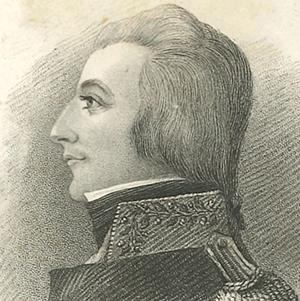July 11
Published in On this Day listing- 1792

Above: Theobald Wolfe Tone—dropped in on the final day of the Belfast Harp Festival but was not impressed: ‘The harpers again. Strum, strum and be hanged.’
The Belfast Harp Festival, a three-day event, opened in the Exchange Rooms. Perhaps the first attempt in Ireland to actively rejuvenate Gaelic culture occurred in Presbyterian Belfast, then known as the ‘Athens of the North’, a century before the Irish Literary Revival. Organised by a committee chaired by Dr James MacDonnell, a lover of Irish music from the Glens of Antrim, and which included Henry Joy (1754–1835), editor of the Belfast News-Letter and uncle of Henry Joy McCracken, and Thomas Russell, the ‘man from God knows where’, its aim was ‘to revive and perpetuate the Ancient Music and Poetry of Ireland’. Ten traditional Irish harpers (including one woman) and a Welshman were brought together to compete for prizes. They ranged in age from 97-year-old Denis Hempson from Magilligan, Co. Derry, who played the harp in the old style of plucking with the fingernails, to fifteen-year-old William Carr from County Armagh. Six of them, including Hempson, were blind. First prize went to Charles Fanning from County Cavan and second to Arthur O’Neill from County Tyrone, though they were all given a payment. Significantly, the committee had commissioned the nineteen-year-old Edward Bunting to write down the music as it was being played, which he duly did, along with a mine of information about the harpers themselves and harp lore. His collection, arranged for piano, was subsequently published in three volumes, notably The ancient music of Ireland (1840). No doubt many United Irishmen—the society had been founded in the nearby Peggy Barclay’s tavern nine months earlier—were impressed by the event, but not so Theobald Wolfe Tone. Dropping in on the final day, he famously wrote in his diary: ‘The harpers again. Strum, strum and be hanged.’
- 1921 The Truce in the War of Independence came into effect. Since January that year well over 1,000 lives had been lost in the conflict, including 61 lives over the four days since the truce was announced.
- 1938 Taoiseach Éamon de Valera raised the tricolour in Cork Harbour as Éire took possession of Spike Island, Fort Camden and Fort Carlisle under the terms of the Anglo-Irish Agreements of 25 April 1938.
- 1927 Kevin O’Higgins (35), vice-president of the executive council and minister for justice, was assassinated as he made his way to Mass in Booterstown, Co. Dublin.
- 1921 A truce in the Anglo-Irish war came into effect.
- 1767 John Quincy Adams, sixth president of the United States (1825–9), born in Massachusetts, the son of John Adams, the second president (1797–1801).
- 1274 Robert the Bruce, King of Scots (1306–29), whose brother Edward in 1315 invaded Ireland, where he conducted a disastrous three-year military campaign, born in Turnberry Castle.
















